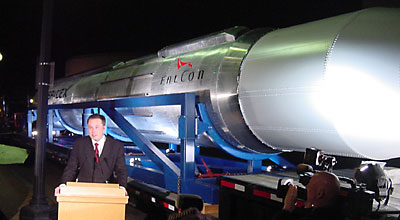Reducing launch costs: a lower limit?by Jeff Foust
|
| “It’s difficult to get the total flyaway costs below about $20 million,” Buckley concluded. |
The reason why that’s the case, he said, is something called the rocket cost equation, which splits the flyaway cost of a launch into five major components. The launch vehicle contractor costs cover the hardware itself, along with required enhancements and analysis. Range safety costs include both the direct range costs of the launch as well as cost of going through the range safety approval process. Launch site facilities costs cover payload and launch vehicle processing. The “launch agency” costs cover equipment provided by the agency (which, in the case of the RSLP, could include ICBM stages), personnel costs, and mission assurance activities. Finally, a miscellaneous category covers other costs not included in the categories above, which might include additional studies or payload adapters.
Buckley’s analysis found that, for a typical RSLP launch, the launch vehicle contractor costs take up about 65 percent of the total flyaway cost: $13 million for a $20 million launch. Launch agency costs take up 15 percent, with range costs taking up another 10. The remaining 10 percent is split evenly between the launch site facilities and miscellaneous categories. Many of those costs are fixed, so that if the vehicle hardware cost goes down, the share of the flyaway costs absorbed by those other components increases: Buckley estimated that if the launch vehicle contractor costs were cut roughly in half, to $7 million, the total flyaway cost would still be about $13 million.
One of the big drivers of those costs is labor. He estimated that a typical launch team has about 50 people on it. At fully-burdened labor rates, he calculated, that works out to as much as $7.5 million a year in labor costs alone—regardless of the number of launches the team is responsible for. Given that most US small launch vehicles are used sparingly—the original Minotaur, now called Minotaur 1, is scheduled to launch late this year or early next year on its first flight since mid-2000—those labor costs can not be amortized over very many launches. Worse, Buckley noted, labor costs typically go up a few percent each year in accordance with the cost of living.
Solutions to the equation
There are ways to deal with those costs, Buckley believes. High labor costs can be mitigated by reducing the size of launch teams, although he didn’t estimate by how much team sizes could be cut without jeopardizing the safety or success of launches. Another way to handle high labor costs is to spread them out over a greater number of launches. A typical $20-million launch today could cut its costs by $5-7 million if launch rates increased to 10-20 missions a year. This cost savings comes not only from reducing the labor “cost share” for each launch, but also through more efficient operations and cost reductions in various components through bulk purchases.
| “I hope that you prove that I’m wrong,” Buckley said. “No one wants to reduce launch costs more than me.” |
Buckley also believes that streamlining range operations can also help reduce costs—a belief no doubt shared by the private sector, which has often complained about the bureaucratic processes and high costs involved when dealing with the major US ranges. An increased launch rate would also help here by spreading out range and launch site costs over a larger number of launches. Launch customers can also help reduce costs by minimizing the number of vehicle enhancements and unique requirements they believe they need.
While these options can cut several mission dollars from the cost of a launch, it doesn’t provide the radical costs cuts long sought after the space community and promised by many government and private efforts. In its place, Buckley offered a “trivial” solution to the rocket cost equation, at least for the case of launching small satellites. Instead of trying to drive down the cost of the launch, he argued, instead try to get the most capable vehicle available for $15-20 million a launch. If the vehicle has a multimanifesting capability, he argued, it could carry several satellites for a few million dollars each. A primary payload might pay $7-10 million for the launch, while several secondaries would pay $4-6 million each. His solution also requires having such launches available every one to two years.
That solution may seem disappointing to many people who are looking for more radical launch cost cuts. SpaceX, for example, is promising launches of the Falcon 1, a Minotaur-class vehicle, for $5.9 million (plus range fees) per launch, while the DARPA-Air Force Falcon small launch vehicle seeks to place 450 kg into orbit for just $5 million a launch. Despite his beliefs about launch costs, Buckley is rooting on these efforts. “I hope that you prove that I’m wrong,” he said. “No one wants to reduce launch costs more than me.”
